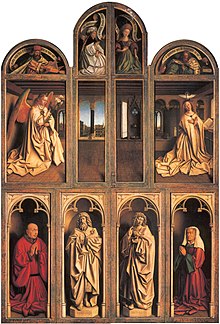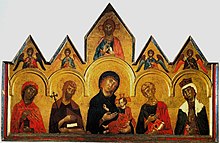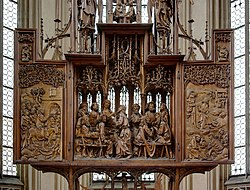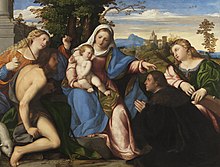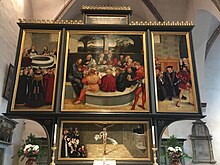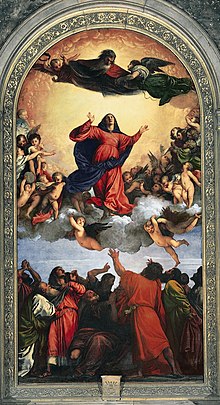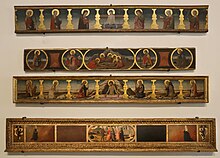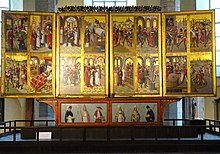
In art a predella is the lowest part of an altarpiece, sometimes forming a platform or step, and the painting or sculpture along it, at the bottom of an altarpiece, sometimes with a single much larger main scene above, but often, a polyptych or multipanel altarpiece. In late medieval and Renaissance altarpieces, where the main panel consisted of a scene with large figures, it was normal to include a predella below with a number of small-scale narrative paintings depicting events from the life of the dedicatee, whether the Life of Christ, the Life of the Virgin or a saint. Typically there would be three to five small scenes, in a horizontal format. Sometimes a single space shows different scenes in continuous representation.

A polyptych is a painting which is divided into sections, or panels. Specifically, a diptych is a two-part work of art; a triptych is a three-part work; a tetraptych or quadriptych has four parts, whereas a polyptych describes any work of art formed of more than one constitutive part.

Pietro Lorenzetti or Pietro Laurati was an Italian painter, active between c. 1306 and 1345. Together with his younger brother Ambrogio, he introduced naturalism into Sienese art. In their artistry and experiments with three-dimensional and spatial arrangements, the brothers foreshadowed the art of the Renaissance.

A reredos is a large altarpiece, a screen, or decoration placed behind the altar in a church. It often includes religious images.
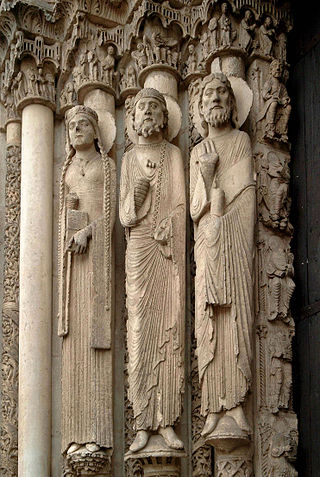
Gothic art was a style of medieval art that developed in Northern France out of Romanesque art in the 12th century AD, led by the concurrent development of Gothic architecture. It spread to all of Western Europe, and much of Northern, Southern and Central Europe, never quite effacing more classical styles in Italy. In the late 14th century, the sophisticated court style of International Gothic developed, which continued to evolve until the late 15th century. In many areas, especially Germany, Late Gothic art continued well into the 16th century, before being subsumed into Renaissance art. Primary media in the Gothic period included sculpture, panel painting, stained glass, fresco and illuminated manuscripts. The easily recognizable shifts in architecture from Romanesque to Gothic, and Gothic to Renaissance styles, are typically used to define the periods in art in all media, although in many ways figurative art developed at a different pace.

A retable is a structure or element placed either on or immediately behind and above the altar or communion table of a church. At the minimum, it may be a simple shelf for candles behind an altar, but it can also be a large and elaborate structure. A retable which incorporates sculptures or paintings is often referred to as an altarpiece.
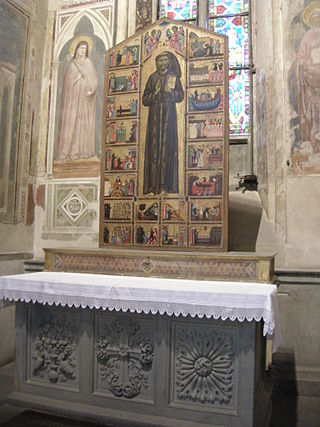
A Dossal, from French dos (back), is one of a number of terms for something rising from the back of a church altar. In modern usage, it primarily refers to cloth hangings but it can also denote a board, often carved or containing a painting, that rises vertically from the back of the altar and to which the cloth is attached. Retable and reredos are alternative terms for solid structures, as is altarpiece, all of them rather more commonly used today.
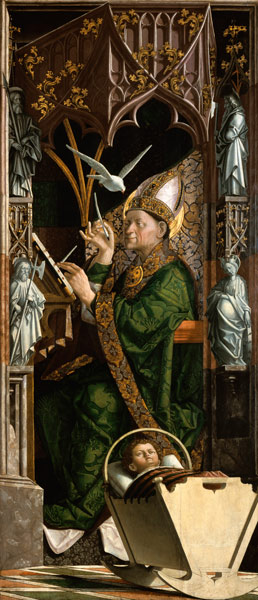
Michael Pacher was a painter and sculptor from Tyrol active during the second half of the fifteenth century. He was one of the earliest artists to introduce the principles of Renaissance painting into Germany. Pacher was a comprehensive artist with a broad range of sculpting, painting, and architecture skills producing works of complex wood and stone. He painted structures for altarpieces on a scale unparalleled in North European art.

The Mond Crucifixion or Gavari Altarpiece is an oil on poplar panel dated to 1502–1503, making it one of the earliest works by Italian Renaissance artist Raphael, perhaps the second after the c.1499-1500 Baronci Altarpiece. It originally comprised four elements, of which three survive, now all separated: a main panel of the Crucified Christ with the Virgin Mary, Saints and Angels which was bequeathed to the National Gallery, London, by Ludwig Mond, and a three-panel predella from which one panel is lost; the two surviving panels are Eusebius of Cremona raising Three Men from the Dead with Saint Jerome's Cloak in the Museu Nacional de Arte Antiga, in Lisbon, and Saint Jerome saving Silvanus and punishing the Heretic Sabinianus in the North Carolina Museum of Art.

The San Zeno Altarpiece is a polyptych altarpiece by the Italian Renaissance painter Andrea Mantegna created around 1456–1459. It remains in situ in the Basilica di San Zeno, the main church of the Northern Italian city of Verona. Mantegna's style mixes Greco-Roman classical themes along with Christian subjects in this altarpiece. The central panel, along with the three paintings that comprise the predella, were taken in 1797 by the French. While the main, central scene was returned by the French to Verona in 1815, the three predella paintings in Verona today are copies, since the original ones remain in France at the Louvre (Crucifixion) and in the Musée des Beaux-Arts in Tours. The paintings are made with tempera on panel; not oil as mistakenly identified in one source.

The Stefaneschi Altarpiece is a triptych by the Italian painter Giotto, from c. 1320. It was commissioned by Cardinal Giacomo Gaetani Stefaneschi to serve as an altarpiece for one of the altars of Old St. Peter's Basilica in Rome. It is now at the Pinacoteca Vaticana, in Rome.
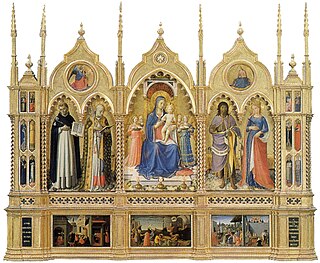
The Perugia Altarpiece is a painting by the Italian early Renaissance painter Fra Angelico, housed in the Galleria Nazionale dell'Umbria of Perugia, Italy.

The Fiesole Altarpiece is a painting by the Italian early Renaissance master Fra Angelico, executed around 1424–1425. It is housed in the Convent of San Domenico, Fiesole, central Italy. The background was repainted by Lorenzo di Credi in 1501.

The Crucifixion is a panel in the central part of the predella of a large altarpiece painted by Andrea Mantegna between 1457 and 1459 for the high altar of San Zeno, Verona (Italy). It was commissioned by Gregorio Correr, the abbot of that monastery.

The Saint Augustine Altarpiece is a Catalan Gothic painting in egg tempera by Jaume Huguet and Pau Vergós made between 1462 and 1475. The long duration of the work was caused by financial reasons, and it is assumed that work was begun by Huguet and finished by other members of his workshop, in particular Pau Vergós. The altarpiece was commissioned by the guild of tanners to be placed on the altar of the Augustinian friary of Sant Agustí Vell in Barcelona, Spain. The panel measures 250 × 193 × 9.5 cm and has been in the Museu Nacional d'Art de Catalunya (MNAC) in Barcelona since 1927.

The San Pietro Polyptych is a polyptych by Italian Renaissance master Perugino, painted around 1496–1500. The panels are now in different locations: the lunette and the central panel, depicting the Ascension of Christ, are in the Museum of Fine Arts of Lyon, France.
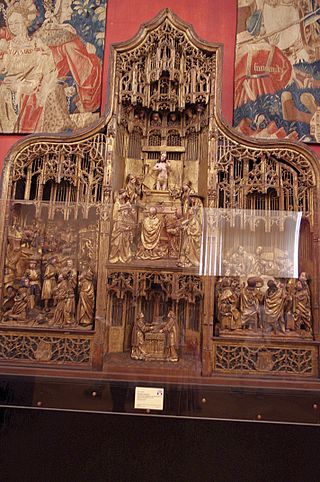
Jan de Molder was a Northern Renaissance wood carver active in Antwerp in the early 16th century. His work represents the beginnings of Antwerp Mannerism.

A winged altarpiece or winged retable is a special form of altarpiece, common in Northern and Central Europe, in which the central image, either a painting or relief sculpture can be hidden by hinged wings. It is called a triptych if there are two wings, a pentaptych if there are four, or a polyptych if there are four or more. The technical terms are derived from Ancient Greek: τρίς: trís or "triple"; πέντε: pénte or "five"; πολύς: polýs or "many"; and πτυχή: ptychē or "fold, layer".

The Santa Maria dei Fossi Altarpiece is a 1496-1498 painting by Pinturicchio, now in the Galleria nazionale dell'Umbria in Perugia. Unusually for an altarpiece, it is painted on canvas stretched over wooden panels.

Adoration of the Magi is a painting in tempera on wood panel by Luca Signorelli (1450–1523) and his assistants, executed c. 1493–1494, and now in the Louvre in Paris. It was probably the first painting he produced in Città di Castello, and originally hung over the main altar of the monastery church of Sant'Agostino. The surface displayed within the frame is 331 cm by 245.5 cm. In late 2022 it was not on display.

